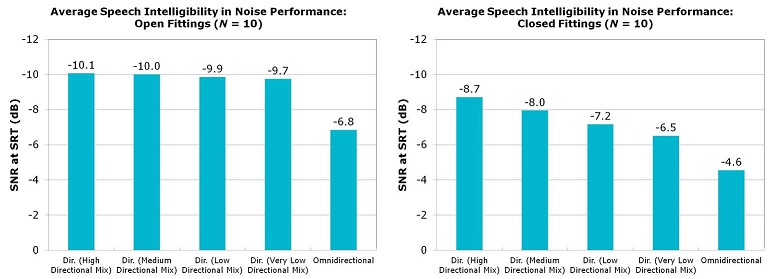Question
What is the impact of bandsplit directionality on speech recognition and perception?
Answer
Hearing-impaired individuals require a better signal-to-noise ratio (SNR) than normal-hearing people for the same speech recognition. Directionality in hearing aids is one way to improve the SNR for the hearing-impaired individuals. However, directionality in hearing aids has some drawbacks. Directional microphones are less sensitive in low-frequency regions than omnidirectional microphones due to similar phase relationships between front and rear microphones for low-frequency sounds. This can result in a loss of audibility for low-frequency sounds and a noticeable change in loudness and sound quality when switching between omnidirectional and directional responses. To resolve this problem, a boost in low-frequency amplification is traditionally applied. The bass boost compensation is used to counter loss of far-field low-frequency sounds caused by a directional microphone. However, that compensation leads to over-amplification of near-field sounds, also known as the proximity effect. The noise floor in the hearing aid is also increased, which may mask other sounds and be annoying for the hearing aid user. This noise perception is noticeable mainly in quiet environments, and is typically reported by hearing aid users who have minimal hearing loss in the low frequencies.
Bandsplit directionality resolves the dilemma between low frequency audibility and noisy sound quality. This type of processing splits the incoming sound into low and high frequency bands, and applies directional processing to only the high band. An additional benefit of this type of directional processing is that it helps maintain spectral cues for front-back localization when microphone location is behind-the-ear.
Regarding the impact of bandsplit directionality on speech intelligibility, Moeller & Jespersen (2013) reported a significant directional benefit of bandsplit directional processing in laboratory testing of speech recognition in noise. Furthermore, they found that the degree of benefit increased to 4 dB over omnidirectional processing as the crossover frequency between the bands was lowered, but only for occluding fittings. For open fittings, they reported a 3 dB improvement in SNR, which did not change depending on the bandsplit frequency. They concluded that providing directionality in the frequency area with the most crucial speech information makes the biggest difference in SNR improvement, and that extending bandwidth across which directionality is applied to lower frequencies adds additional incremental benefit for fittings which are occluding.

ReSound hearing instruments use bandsplit directional processing. The lack of sound quality differences between directional and omnidirectional responses allows for transparent microphone mode switching as well as applying asymmetric directional fitting strategies. The ReSound Aventa software prescribes the bandsplit frequency to achieve the best balance between SNR improvement and sound quality based on the audiogram and the microphone spacing of the device being fit.
References
Møller, K. & Jespersen, C. (2013). The Effect of Bandsplit Directionality on Speech Recognition and Noise Perception. The Hearing Review. Retrieved from www.hearingreview.com

